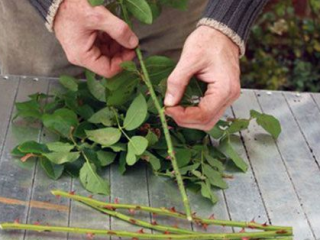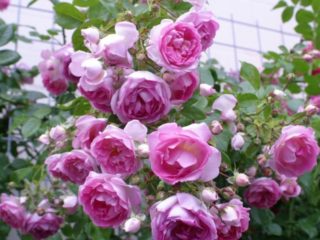Content
The wrinkled hollyhock (Alcea rugosa) is a type of herbaceous perennial plant used for decorative purposes. They have gained considerable popularity among gardeners due to their long flowering time and ease of care. Stock roses have found application in landscape design; they are actively used for decorating areas. The technology for growing in open ground is practically no different from other flowering plants.
Description and characteristics
Rose hollyhock (mallow) is a tall plant with long erect stems. The bush reaches 160-180 cm. The shoots are dense and strong, covered with light green soft bark.
There is no foliage on the top of the plant. There are only basal plates, the diameter of which reaches 12 cm. The leaves are finger-shaped, dark green in color.
The bushes have tap roots. Thanks to this structure, underground shoots grow deep into the ground. This has a positive effect on the resistance of mallow to adverse weather conditions.
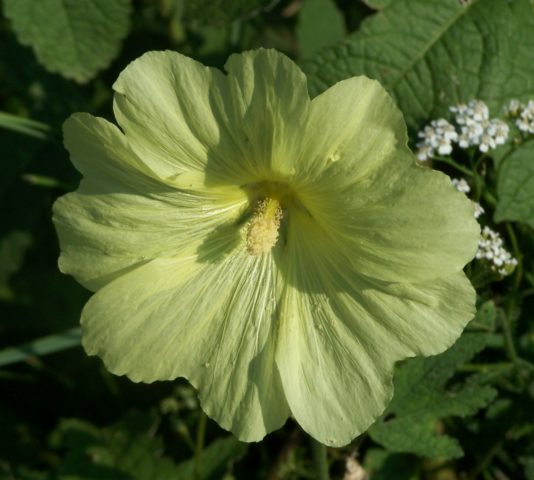
The stock rose begins to bloom in the second year after planting in the ground.
The budding period occurs in early June. Peduncles with small light green leaves form on the upper part of the stems. Mallows bloom in July. During this period, flowers with a diameter of 6-8 cm appear on the wrinkled holly rose. They gather in panicles.
Rose stock is considered an undemanding crop. It grows well in almost any type of soil. Wrinkled mallows do not tolerate a lack of fluid. A prolonged absence of watering shortens the flowering period and can lead to drying out.
Stock roses are characterized by average frost resistance. Wrinkled mallow bushes overwinter in the ground, but they require shelter. A sharp drop in temperature to -10 degrees can greatly harm young bushes.
The plant exhibits resistance to many types of diseases. Wrinkled hollyhock roses are not susceptible to powdery mildew, root rot and most other infections. In summer, mallows can become infested with pests.
Varieties of rose wrinkled
There are over 60 varieties. Most of them are selectively bred for decorative purposes. Species diversity allows you to choose the most suitable plant for the garden. The most popular varieties are described below.
Mallow Garland
The stock rose has erect stems 100-120 cm high. It has large double flowers and five-fingered leaves. The plant is grown from seeds.
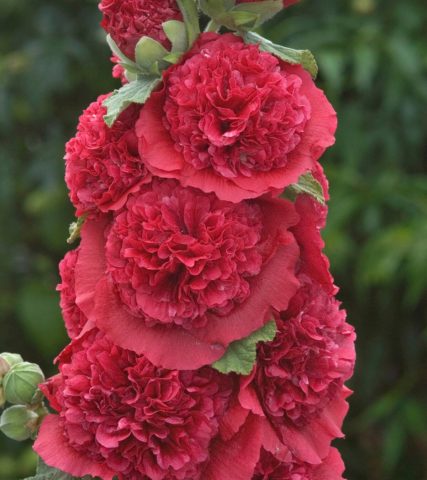
Mallow "Garland" is grown in open ground for 2-3 years, after which it loses its decorative effect.
The color of the flowers is dark red. 5-6 buds are formed on each stem. This species is most similar to garden roses.
Malva Summer Carnival
A domestic variety of wrinkled stock roses, reaching a height of 1.8 m. The plants have large dark green leaves. The flowers are up to 15 cm in diameter. There are 10-12 or more of them on each bud.
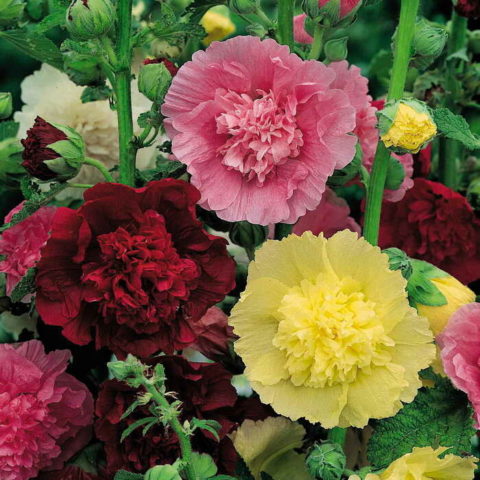
The “Summer Carnival” variety is characterized by a late flowering period - from August to September
The variety is intended for vertical gardening. Typically, mallow is planted near hedges, fences and walls of buildings.
Wrinkled stock roses Yellow Queen
A tall variety of mallow. Bushes reach 2.5. The plant is a hybrid, bred by crossing double and wrinkled stock roses.
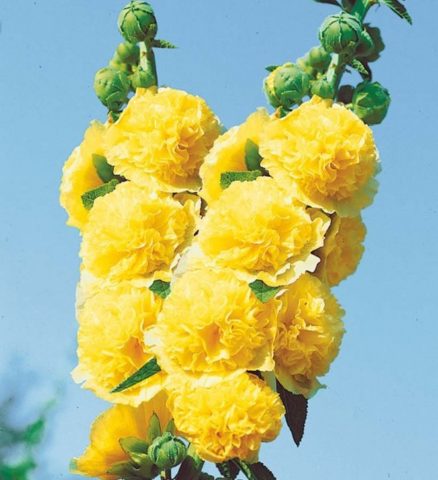
The variety "Yellow Queen" is characterized by increased resistance to drought
The wrinkled hollyhock rose “Yellow Queen” has large double flowers. They usually bloom in the first year after planting in open ground.
Mallow Blackberry Sorbet
A variety of foreign selection, classified as medium-sized. Blackberry Sorbet mallow reaches a height of 200 cm.
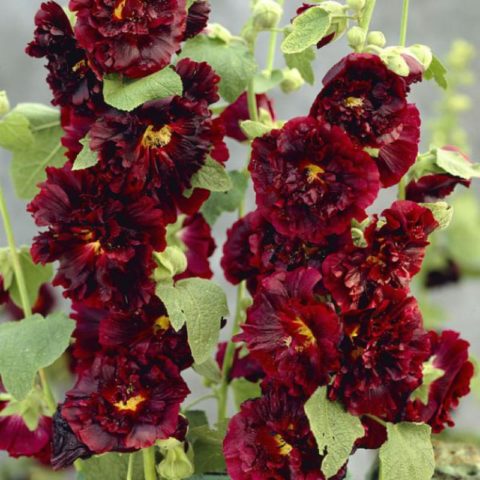
Blackberry Sorbet mallow should be placed in a well-lit area
The flowers are densely double with burgundy and yellow petals. This species is used for group plantings.
Chaterz stock roses
Tall variety - up to 2.5 m. Chatters mallows have large flowers, up to 10 cm in diameter. Color – pink with a slight yellowish tint.
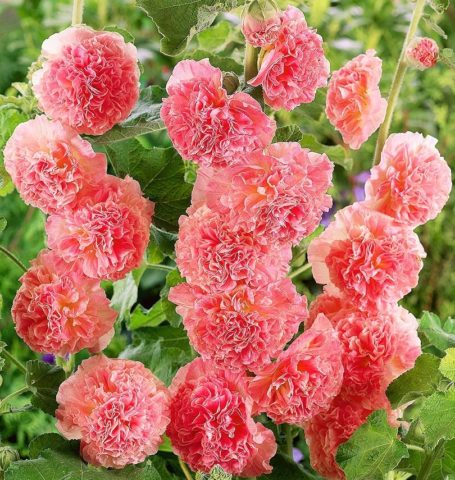
Flowering at "Chaterz" is abundant, lasting from early July to September
The plant is grown no longer than 4-5 years. Gradually it loses its varietal characteristics and blooms worse.
Planting and caring for rugosa rose
To grow a bush in an open area, you must follow several rules. First of all, proper planting is required. It can be complicated by the fact that mallows are grown from seeds.
Landing dates
Usually the plant is immediately planted in open ground. Planting is carried out at the end of April or in May, when the soil has warmed up and the air temperature will always be at least 8 degrees.
When growing in this way, it is necessary to take into account that the germination rate is very high. Almost all seeds germinate, but due to unfavorable conditions, seedlings may wither prematurely.
Requirements for place and soil
Mallows grow well in any type of soil. But in order for wrinkled holly roses to last in the soil as long as possible, it is recommended to choose a place that meets several requirements.
Among them:
- looseness and breathability of the soil;
- presence of nutrient sources;
- moderate humidity and acidity;
- low groundwater table.
For planting, you can use standard soil for flowering plants. Mix compost, garden soil, sand and peat in equal proportions.
It requires a well-lit place to grow. It must be protected from strong winds.
Planting and subsequent care
The area needs to be cleared of weeds. It is advisable to dig and loosen the soil. The seeds are pre-soaked in a weak fungicidal solution to prevent infection.
Planting stages:
- Make indentations in the prepared area.
- Place a small amount of humus or compost.
- Add a little water.
- Place the seeds without burying them in the soil.
- Sprinkle with loose soil in a layer of 2-3 cm.
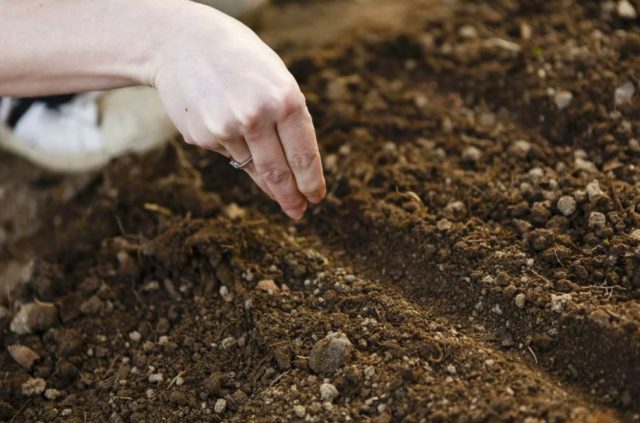
Seeds are sown in furrows or individual holes
Wrinkled holly roses are unpretentious and therefore do not require special care. It is enough to water the bush periodically so that it does not experience a lack of liquid. Weeds around the wrinkled mallow need to be promptly removed.
In summer, as the soil compacts, loosening is required. To retain moisture, the soil is mulched with bark, peat or sawdust.
Tall varieties of stock roses require a garter. Otherwise, the shoots may break due to a strong gust of wind.
Wrinkled mallows do not need mineral supplements. It is enough to apply organic fertilizers 2-3 times a year.
Best suited:
- compost;
- droppings or manure diluted in water;
- peat;
- wood ash.
For the winter, the plant is pruned, leaving short (8-10 cm), superficial shoots. They are wrapped in breathable film or covered with dry leaves and spruce branches.
Pruning wrinkled rose
Mallows are trimmed 2-3 times a year. The wrinkled hollyhock rose is pruned for the first time in the spring, during the period of active shoot growth. Remove excess stems, as well as side root shoots.
In summer or early September, fading flower stalks are cut off. This is necessary for the mallow to prepare for winter. In addition, wrinkled stock roses can reproduce by self-sowing.
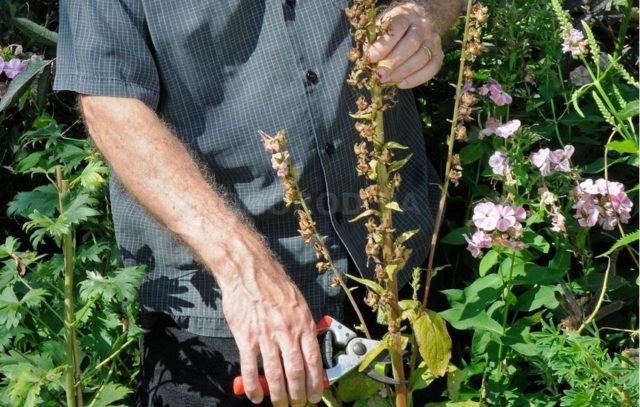
Pruning of flower stalks should be carried out before the formation of seed pods
In autumn, all surface shoots are removed.It is recommended to treat the sections with an antiseptic solution to prevent rotting.
Propagation of wrinkled rose
To obtain new mallow specimens for planting in the garden, you can use one of the proposed methods. Wrinkled holly roses tolerate almost all propagation methods.
Mallow cuttings
Young side shoots growing on the main stems are used as planting material. They are harvested in the spring, after which they are rooted in a nutrient substrate. It is recommended to transplant cuttings into open ground in the fall. Then they will better adapt to new conditions and be able to endure the first winter without damage.
Propagation by seeds
Planting material is collected in September. Seeds are stored in a cool place with moderate humidity. In March, they are soaked in a growth stimulant and sown in a container with nutritious soil.
Shoots appear after 2-3 weeks. They need to be watered regularly. Picking is carried out when the first true leaves appear.
Technology of growing seedlings:
Dividing the bush
This method of reproduction is prohibited for several reasons. Wrinkled mallows do not respond well to removal from the soil and may die when transplanted. Stock roses have a tap root structure. It is not subject to division.
Diseases and pests
Wrinkle hollyhocks rarely get sick. They are resistant to most infections.
Damage to bushes can be caused by:
- rust;
- cercospora;
- ascochyta blight
To prevent diseases, it is enough to carry out a number of preventive measures. They protect the mallows from infection.
Basic measures:
- Transplant the bush to a new location every 3 years.
- Antiseptic treatment of the soil around the plant.
- Spraying bushes with fungicide.
- Timely removal of weeds.
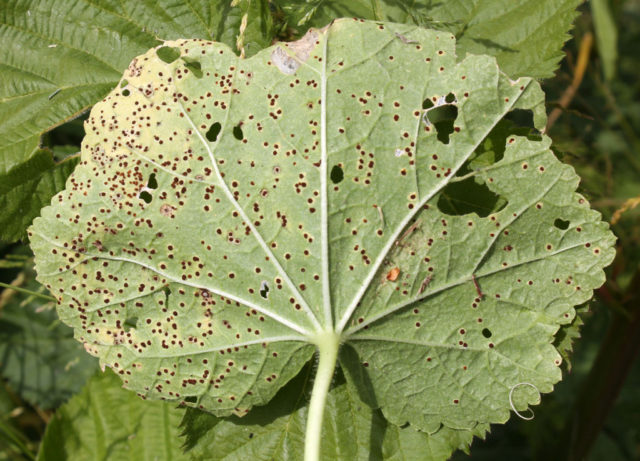
Damage to the sheets indicates infection or insect attack.
Spider mites and aphids are common pests of wrinkled mallow. They are not capable of causing the death of the stock rose, but they affect the decorativeness of the plant. When pests appear, the affected shoots are removed, and the remaining stems are sprayed with insecticides.
Wrinkled rose in landscape design
Mallows are grown in groups. The number of copies directly depends on the preferences of gardeners.
In the photo, wrinkled roses can often be seen near fences and fences. Planting in such places is explained by the fact that the plant is protected from the wind. At the same time, hollyhocks perform a decorative function, landscaping vertical surfaces.
To create hedges, wrinkled roses are planted in rows. The decorative effect of such plantings is evident not only during the flowering period. Until this moment, the area is decorated with large leaves of roses.
Medicinal properties of rose wrinkled holly
Mallow is used in traditional and folk medicine. Extracts of this plant are part of popular antitussive drugs. The components contained in the stock rose help separate mucus from the lungs and remove it from the body.
Other beneficial properties that mallow has:
- moderate tonic effect;
- diuretic effect;
- antidiarrheal effect;
- choleretic effect.
It is believed that brewed rosemary seeds help remove toxins from the body and help you lose weight. Mallow can be used for medicinal purposes only if there are no contraindications.
Conclusion
The wrinkled hollyhock is an unpretentious plant that can be grown in any area.Mallows are distinguished by unique decorative qualities, as well as ease of care. The plant is used for vertical gardening and is usually planted as hedges. The disadvantage of the hollyhock rose is its difficulty in replanting.





